Tips to Make Your Trip More Comfortable
Fare Tips
Safety Tips
Bonus Escalator Safety Tips
Shopping Tips
Tips for the Self-interested
Tips About Patience
Getting a Seat
Catching the Next Train
Catching the Next Bus and Streetcar
Sleeping Tips
Entertaining Yourself En Route
More than Just a Ride
Useful Knowledge
Courtesy, Please
Tips to Aid You Using the TTC Subway Rider Efficiency Guide
Tips for When Your Kids Start Traveling On Their Own
Tips for Traveling with Young Children
Efficiency Tips
The University of Toronto St. George Campus is so large that it's within a 10 minute walk from four different subway stations: Spadina, St. George, Museum and Queen's Park. It's useful to know what area of the campus you are going to before deciding on a route.
— submitted by Theresa Aqui
The sway of the train can help you predict which platform the train will pull into at the terminus stations. This will allow you to choose the right door for exiting.
— submitted by anonymous
Standing at the exit door of the train, bus or streetcar as soon as you are one stop away from your destination allows you to be the first one off.
— submitted by anonymous
When traveling westbound on the 501 Queen streetcar toward Queen Station, it's sometimes quicker to get off at Victoria Street and walk to the subway station rather than wait for the streetcar to inch the last few metres.
— submitted by Jason Paris
During rush hour, when traveling eastbound on King toward St. Andrew Station, it's quicker to get off Simcoe Street and walk to the subway station rather than wait for the streetcar to inch the last few metres.
— submitted by anonymous
When going from Dundas and Yonge to any station north of Spadina, it's usually faster to take the frequent Dundas streetcar to St. Patrick rather than taking the loop around.
— submitted by anonymous
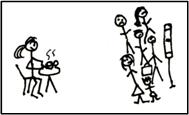 When there is a disruption in subway service, it's almost always a bad idea to board a shuttle bus.
Alternatives:
When there is a disruption in subway service, it's almost always a bad idea to board a shuttle bus.
Alternatives:
— submitted by Jonathan Fuerth |
 Do up your shoes on the subway train to save time. Make sure you are seated while doing this or you may fall over when the train moves.
Do up your shoes on the subway train to save time. Make sure you are seated while doing this or you may fall over when the train moves.
— submitted by Lisa Smolkin |
If you have your fare ready, butt past people in line, insert your fare, and continue on your way while slower people buying their tickets take their time.
— submitted by Lisa Smolkin
If you are only one or two stops away from your destination or transfer point, sometimes it's faster to just walk there.
— submitted by Michael Higginson
If you are in good shape and a fast runner, it's often worth running to try and catch a bus or streetcar, even when it seems like you have little chance. You'd be surprised how often you can make a miracle catch — and it makes your whole trip feel special.
— submitted by Michael Higginson
When you're running for a streetcar, wave at the driver as it passes you. Sometimes they'll pull over at the stop and wait for you. A clear, confident signal lets them know it's worth their while, and it probably also helps to have a non-aggressive, human connection. At the very least, if they don't stop, you can feel justified in calling them a dickhead or bitch.
— submitted by anonymous
During peak times, it may be worth walking south and catching the Spadina streetcar southbound at Sussex Avenue instead of Spadina Station. During rush hour you may save five or more minutes. This is because if you have manners and stand in line for the streetcar at Spadina Station, the line is often so long that you have to let two or three cars go by before you can board one. By walking south to the next stop you're likely to be one of the only people boarding at that stop, so they'll let you on even if the car is jam-packed.
— submitted by Ontarian1976
When traveling between Scarborough Town Centre and Kennedy Station during rush hour, consider the Nugget Express (if you see it waiting in its bay) instead of the Scarborough RT. It's often about equal to the RT's travel time. The best thing about this is that you won't have to go up to the RT platform and fight your way back down at STC — you stay at the bus bay level.
— submitted by scarberiankhatru
When crossing from the University/Spadina subway to the Bloor line, the options are to do this at Spadina or St. George stations. It's much quicker to do this at St. George Station as the north/south and east/west platforms are directly above/below each other. At Spadina Station, there is a long walk between the north/south and east/west trains.
— submitted by anonymous
When near the bottom of the University line and you plan on transferring to the Bloor/Danforth subway (particularly eastbound), take the next train; whether it's north or south. It's the same number of stops from St. Andrew Station to Bloor/Yonge Station. Even at Osgoode or St. Patrick, if a train arrives going southbound first, you might save time by just catching that instead of waiting for the northbound train.
— submitted by anonymous
When traveling on the RT to Scarborough Town Centre, get up and wait by the doors before the train gets to Midland Station. Few people use Midland and by the time the train stops there, a lot of people are heading for the doors.
— submitted by anonymous
When riding to a downtown stop on the Yonge-University line, if your destination is on the opposite line, it's usually faster to stay on the train and ride around Union than it is to switch to a Bloor/Danforth train and then switch back. For example, if riding south from Finch to Queen's Park, stay on the train and go around Union, rather than getting off at Bloor, riding the train to St. George, and then getting back on a southbound University train.
— submitted by holypotato
The orange dot on six-car subway platforms can be used as an easy way to remember where to wait for the train on the platform, so that when you get to your destination station, you're lined up near the stairs or escalators. The orange dot is attached to the wall in each subway station and lines up to approximately the 3rd car, 3rd door of each train.
Destination stations where the orange dot is useful:
- Bathurst (eastbound and westbound)
- Bay (eastbound and westbound)
- Broadview (eastbound)
- Castle Frank (eastbound)
- Chester (eastbound and westbound)
- Christie (eastbound and westbound)
- Coxwell (westbound)
- Davisville (eastbound and westbound)
- Donlands (eastbound)
- Dufferin (eastbound and westbound)
- Dupont (northbound and southbound)
- Eglinton (northbound and southbound)
- Finch (northbound and southbound)
- Islington (eastbound and westbound)
- Jane (eastbound and westbound)
- Kennedy
- King (northbound and southbound)
- Main Street (eastbound)
- North York Centre (southbound)
- Osgoode (northbound and southbound)
- Pape (eastbound and westbound)
- Queen's Park (northbound)
- Runnymede (eastbound and westbound)
- Sheppard (northbound and southbound)
- Sherbourne (westbound)
- St. Andrew (northbound)
- St. George (eastbound, westbound, northbound and southbound)
- St. Patrick (southbound)
- Union (westbound — towards University line)
- Victoria Park (eastbound)
- Warden (eastbound and westbound)
- Wellesley (southbound)
- Wilson (northbound and southbound)
- Yonge (westbound)
A simple way to remember which stations are orange dot stations is to remember them as an acronym:
BBBCCCCDDDDDEFIJKKMNOPQRSSSSSUVWWWY
Pronounce it out like a word and remember it by the way it sounds.
— submitted by Hayley Watson
If there's a flight of stairs next to an escalator that goes in only one direction (e.g., an up escalator, but not a down escalator), take the stairs only if you are not going in the same direction as the escalator, otherwise you may be beaten back by the traffic coming from the opposite direction.
— submitted by anonymous
To know what door will be used at the end of the line, upon pulling into the last station, look at the signals in the tunnel before the crossover:
Yellow over Green: the train will not cross to the other track
Yellow over Yellow: the train will cross to the other track
For example, when the Yonge train arrives at Finch, as the train arrives on the northbound track, if the signal is Yellow over Green, the train will remain on the northbound track and the doors on the west side will open. If the signal is Yellow over Yellow, the train will crossover to the southbound track and the doors on the east side will open. Note that you need to be at the front of the lead car to look out the window to see the signals.
— submitted by orion_9430
If you are going from a station on the Yonge line to a station on the Spadina line (or vice versa), it's often faster to take the subway down to the Bloor line and back up than to take the bus over to the other subway line. For example, when going from Eglinton to Yorkdale, it's slightly faster to go down to Bloor, take the Bloor line over to St. George, then take the Spadina line up to Yorkdale, than it is to take the bus over to Eglinton West and the subway up to Yorkdale.
— submitted by anonymous
Most of the time, it's best to choose the route with the fewest transfers; otherwise you'll spend more time waiting for the next bus, streetcar or subway than you'll save in travel distance. e.g., if you're on St. Clair between Bathurst and Dufferin, and you're going south to catch the College streetcar, take the Dufferin bus, as it will go straight down to College in on trip, where as the Bathurst route would mean transferring from the Bathurst bus to the Bathurst streetcar at Bathurst Station.
— submitted by Zanis Valdmanis
Generally, take a route that maximizes subway use — subways were built for speed and are usually about twice as fast as surface routes.
— submitted by Zanis Valdmanis
If your destination is between Bathurst and Spadina anywhere south of College, take the Bathurst streetcar over the Spadina one. It's faster.
— submitted by Zanis Valdmanis
Before pulling into the station at Finch, sometimes the operator will say platform 1 or platform 2. Platform 1 means that the train will go to the west side of the platform, meaning the doors will open facing east. Platform 2 means that the train will go to the east side of the platform, meaning the doors will open facing west.
— submitted by Dennis Yip
When exiting College Station through College Park to catch eastbound streetcars, you will pass through a transitional area between the subway exit and the actual mall. Instead of going through the glass doors that lead to College Park, veer left to the unmarked door. This leads to a back hallway where the food court washrooms are located, and the other end of the hall exits much closer to the base of the escalators that take you up to ground level. It's a shorter route, you avoid any lineups at the TD cash machines, and you don't collide with people coming off the descending escalator.
— submitted by Chris
Passengers transferring from the bus area onto the subway at Eglinton Station use the southernmost stairs on the platform. In rush hour, the area with the fewest waiting passengers is in the middle of the platform.
— submitted by Sio McLaughlin
If you are on the street at Yonge and Queen, and you want to ride northbound, the best way to enter the subway is through the CIBC building on the southeast corner of the intersection, which does not have a noticeable TTC sign. If you take the obvious entrance through the Eaton Centre you have to take a detour under the tracks to get to the northbound platform.
— submitted by Nick Dingle
When traveling down the University line to Union, if you are heading east into the PATH, stand on the platform so that you get into the second car from the front, then exit the second door from the back for stairs, or the rear-most door of the second car if you want an escalator.
— submitted by Rob Stewart
Tips to Make Your Trip More Comfortable
Try taking the 85 Sheppard East from Sheppard-Yonge Station instead of the Sheppard subway line. You avoid stairs; if you're continuing east of Don Mills Station, you already have a seat and avoid the long lineup at Don Mills Station for the bus you're on, and it's possible to be dropped off at a stop closer to your destination if it's between two stations along the Sheppard subway line.
— submitted by ny_yankeesguy
When you want to get off at the front of the bus, avoid being jerked roughly when the bus stops by leaning forward and at the same time swinging yourself around 90 degrees so that you're on the steps by the time the bus comes to a halt.
— submitted by Diana MacPherson
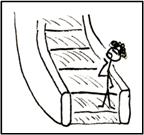 If no one is on the escalator "stand" side, use it instead of the escalator "walk" side — even if you plan on walking. This way you can move at your own leisurely pace as there will be no pressure to actually even walk at all.
If no one is on the escalator "stand" side, use it instead of the escalator "walk" side — even if you plan on walking. This way you can move at your own leisurely pace as there will be no pressure to actually even walk at all.
— submitted by Lisa Smolkin |
If you're at College Station and you're going to north of Spadina on the Spadina Line, it's simpler to go southbound and around Union Station than it is to cross over lines twice.
— submitted by anonymous
Hold your nose when riding the SRT between Midland and Ellesmere. There is a bad smell attributed to several things: a parking lot for garbage trucks, a paper processing factory and a recycling plant.
— submitted by anonymous
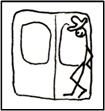 When waiting at Yonge Station for the Bloor eastbound train during rush hour, let everyone waiting on the platform get on first, then as you get on last, you will be able to secure a spot in the doorway. This doorway will no longer be used as all stations east of Yonge use the outside platform doors until Warden. You can now get comfortable without getting in anyone's way.
When waiting at Yonge Station for the Bloor eastbound train during rush hour, let everyone waiting on the platform get on first, then as you get on last, you will be able to secure a spot in the doorway. This doorway will no longer be used as all stations east of Yonge use the outside platform doors until Warden. You can now get comfortable without getting in anyone's way.Securing a doorway this way also works well for other stretches of the subway line: Eglinton to Union St. George to Islington King to Spadina St. George to Glencairn — submitted by The Rothko Institute |
If you're stuck in a delay in a relatively quiet time of the day (e.g., late at night), and would like to know what's holding you up, you can position yourself near the operator's booth in your car and overhear what's happening on the intercom.
— submitted by Chad Mounteny
If you want your ride to be air-conditioned, use an accessible bus.
— submitted by Jonathon Markowski
Keele Street buses (2600s) have soft, cushioned seats.
— submitted by Jonathon Markowski
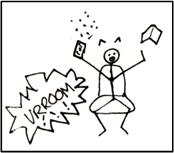 If you board a bus that is not making any noise, beware, when the driver starts it up, it might startle you.
If you board a bus that is not making any noise, beware, when the driver starts it up, it might startle you.
— submitted by Jonathon Markowski |
If a bus makes a sharp turn, lean in the opposite direction. You won't fall over as easily.
— submitted by cppainter2001
On streetcars, for the seats facing forward, there are usually two rows beside each window. Sit in the back row of the two, as it gets a better view out the window. The front row of the two has an obstructed view.
— submitted by Todd Irvine
When passengers empty a TTC vehicle, they usually all head in one direction (e.g., towards the subway system) — wait on the side of the door that's opposite the direction the passengers are going to avoid being swept up in their rush.
— submitted by anonymous
When waiting for a train at your originating station, wait away from the exit to avoid the oncoming rush of passengers leaving the train. For example, the westbound platform for Dundas West Station has an exit at the far west side of the platform. Most regular users of this station know this, and usually crowd at the front car of the train when leaving downtown. Wait near the east end of the platform to avoid this crowd.
— submitted by tjswales
If you're standing on the platform waiting for the train and you want to know if it's near, and if tunnel curves, preventing you from seeing very far, close your eyes and try to feel the wind the train is generating.
— submitted by Matthew Blackett
After a delay in service has been cleared, it may be to your benefit to let that first, crowded train pass. There will probably be more room on the second train after service has resumed.
— source: WMATA
On any given train, one or two cars may be packed. But that doesn't necessarily mean the entire train is crowded. Shop around as you develop routines. Try boarding different cars to see if there is more room elsewhere.
— source: WMATA
If you have flexibility in your arrival and departure times at work, consider riding outside peak hours — after 9:30 a.m., before 3:30 p.m. and after 6:30 p.m. weekdays.
— source: WMATA
If you have to ride during peak commuting periods, try to avoid the most crowded times, 7:45 to 8:45 a.m. and 4:45 to 5:45 p.m.
— source: WMATA
If northbound Yonge trains are completely full, consider boarding the very last car. It often has more space.
— submitted by anonymous
Sit on the subway facing either forward or backward, rather than on the horizontal seats. It's more comfortable as you don't get tossed around as much, there's less strain on the back, and these seats aren't used as footrests.
— submitted by anonymous
If you're unlucky enough to live near a station that is open to the outside (Dundas West, Warden, Davisville, etc.) dress warmly in winter. It is even less fun to wait for the train when you are cold.
— submitted by Liz Clayton
Warden station sucks. It's cold, ugly and super windy. Do not move or work near there.
— submitted by anonymous
In the mornings when riding south into St.Clair West Station, if you're standing up in a crowded subway car, look out the left-hand window towards the centre track just before entering the station. Half the time there will be an empty train sitting there. Get off the train at St. Clair West and wait for the empty train. While it will extend your trip by a few minutes, you will be sitting down and relaxing in a less crowded train for the remainder of your trip. If you ride on other parts of the line, watch for similar situations as transit control short-turns trains elsewhere in the system.
— submitted by Rob Stewart
If you don't like to walk, consider taking the 97 Yonge bus. It has more stops along Yonge than the subway system and may drop you closer to your destination. It runs along Yonge between Front and Steeles.
— submitted by anonymous
Fare Tips
When you first pay your fare, grab a transfer. You may not think you need it at the start of your journey, but something may come up en route. Make sure your transfer doesn't end up as litter.
— submitted by Calvin So
For a monthly pass to be worthwhile you have to use it more than two trips every weekday (at least 48 times in a month). If you are taking a week off (as many do during December) it may not be worth it. On the other hand, even if you don't get the full value, it's often worth it for the freedom to get off and on whenever you like and the convenience of not worrying about having enough tokens.
— submitted by Darwin O'Connor
On Saturdays and Sundays, if you have two adults traveling together, a day pass costs only 10 cents more than four tokens — the amount two people would use on one return trip. If you take at least one more trip beyond that, you've recouped your money and then some. Throw in up to four kids, and save even more.
— submitted by Darwin O'Connor
In the winter, carry your fare on the inside of your glove for easy access and quick fare payment.
— submitted by anonymous
Before you leave your house, store a token under your wristwatch for easy access when you go to pay your fare.
— submitted by Liz Clayton
Use TTC tickets instead of tokens if you find you lose tokens. Tickets fit nicely in your wallet and won't slide out.
— submitted by anonymous
If you regularly use tickets, carry a few extra tokens just in case you find yourself at an automatic entrance with no ticket collector, or in a very long line at the collector's booth.
— submitted by anonymous
Carry an unused day pass in your wallet for occasions when you may want to start the day using a day pass (when you know you're going to use the TTC at least five times that day), but you're not starting off at a subway station (the only place you can buy a day pass). Be careful how you carry it though — the day pass numbers can rub off and render it useless. Fold the pass with the numbers on the inside and ensure the fold creases aren't through the middle of the numbers.
— submitted by anonymous
If you're with a buddy who is about to pay $2.75 to board the bus or streetcar, sell them one of your tickets or tokens for $2.10.
— submitted by anonymous
If you're considering signing up for the Metropass Discount Plan (MDP), but you're not 100% sure you'd need one every month, consider signing up anyway. You can cancel the plan midway through the term and you'll only have to pay the difference between the MDP price and the regular Metropass price (i.e., what you would have ended up paying for a Metropass had you never signed up to the MDP).
— submitted by anonymous
Make sure you take a transfer if riding the Queen streetcar. The Queen 501 uses a Proof-of-Payment honour system (allows people who have already paid and are holding a transfer or pass to enter through the streetcar's back doors) and you may be asked by TTC staff to prove you've paid.
— submitted by anonymous
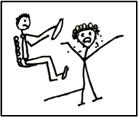 If you forgot your transfer at your originating subway station, grab a transfer at your transfer point and explain to the bus or streetcar driver what happened. They will usually let you on, especially if you look like you are about to cry.
If you forgot your transfer at your originating subway station, grab a transfer at your transfer point and explain to the bus or streetcar driver what happened. They will usually let you on, especially if you look like you are about to cry.
— submitted by anonymous |
On the 512 St. Clair streetcar route, a transfer allows unlimited travel for 2 hours. So, if you live on St. Clair Avenue, you can go shopping on St. Clair Avenue, take your stuff home, and then go downtown all for a single fare.
— submitted by ph_henry14
If you've forgotten to grab a transfer and need to one complete your trip, get off at any station en route (except for the destination station), and grab a transfer.
— submitted by Chad Mounteny
Bonus efficiency tip: If you're lined up near the exits for Dundas Station (best position 2nd car, 4th door southbound or 5th car, 3rd door northbound) and your trip takes you past Dundas Station, then you can get off and quickly grab a transfer from a machine located on the same platform as the train. If you're fast enough, you can reboard the same train and continue on your journey without delay.
— submitted by anonymous
Students and seniors can pick up plastic Metropass holders from fare collectors at subway stations. They will hold your pass and id, and make them easy to flash to drivers as you board the TTC.
— submitted by anonymous
Buy a plastic token holder to easily carry your tokens — they are hard to find, but sometimes available at dollar stores. (Editor's note: please email sean@ttcrider.ca if you know a place that sells token holders.)
— submitted by anonymous
If you're considering buying a monthly pass, but you're not sure, try a weekly pass instead. This will give you the feel of a monthly pass, without the investment. It can be a different mindset taking the TTC when you have unlimited travel and convenient access versus paying for each trip.
— submitted by anonymous
Use TTC fare as currency. For example, if you have dinner with a friend, and you end up paying for most of the meal because your friend only has big bills, you can ask them to pay you back in TTC fare (each ticket/token is worth $2.10).
— submitted by anonymous
If you enter the wrong platform at Dundas, the only way to get to the other platform is to exit the fare-paid area. All you have to do is obtain a transfer and show it to the booth collector at the other platform. They will let you in without paying another fare, as this is a very common mistake.
— submitted by Rajiv O
Safety Tips
Don't use the TTC bathrooms. (Editor's note: exceptions are the new stations — Downsview and Don Mills don't seem too bad.)
— submitted by Liz Clayton
Don't go into the subway tunnels. This used to be done by urban explorers to access places like Lower Bay, but they figured out it wasn't very smart. Trains, whether they be on their regular routes, or training cars or other cars, use all the tunnels, and a train going at full speed can suck you right out of a hiding spot, pulling you into it and crushing you. You can visit Lower Bay by going on a tour or being part of a film shoot, or vicariously through others that have done so in the past.
— submitted by Julie Fournier
When disembarking a train which lets you off near a staircase, beware of those who may be rushing down to catch the train and are not yet within sight of you, thus avoiding a bumpy encounter. Use the round mirrors in the upper corners of the TTC station to see if anyone's coming.
— submitted by purple_pig
 If you have fears about an unstable person pushing you into the path of a moving train, stand at the far end of the platform from where the train enters the station. If this unfortunate event occurs, it will give you an advantage because the train will be near or at a complete stop by the time it reaches you.
If you have fears about an unstable person pushing you into the path of a moving train, stand at the far end of the platform from where the train enters the station. If this unfortunate event occurs, it will give you an advantage because the train will be near or at a complete stop by the time it reaches you.
— submitted by Vaughn G. Pardy |
Wait in the DWA area on the subway/RT platforms. It has extra lighting, an intercom connected to the station collector, a closed circuit TV camera, public telephone and bench, and is near where the guard's car stops on the subway and where the driver's car stops on the SRT.
— submitted by anonymous
The request stop program is available to women traveling by bus or streetcar between 9 p.m. and 5 a.m. and allows them to get off in between regular stops. Requests should be made at least one stop ahead of the desired location.
— submitted by anonymous
Before you get on a bus or train, there are a couple of numbers you may wish to take note of in case you lose something or some other emergency arises. On the front of each bus and train is a small white number on a black background. This is called the run number and is unique for each bus or train route. In addition you can note the car or bus number. If you lose your wallet it makes it easier for transit control if you tell them "I was on run 23 on Dufferin at 7:40 a.m." or "I was on bus 1234 on Dufferin at 7:40 a.m." Just saying "I was on the Dufferin bus at 7:40 a.m." means that transit control has to work a harder to figure out what bus or train you were on and there is less chance of your issue being resolved.
— submitted by Rob Stewart
Bonus Escalator Safety Tips
Step on and off carefully.
— source: TTC Escalator Safety Steps Pamphlet
Hold the handrail.
— source: TTC Escalator Safety Steps Pamphlet
Carry parcels. Do not rest them on handrails.
— source: TTC Escalator Safety Steps Pamphlet
Don't rush other passengers.
— source: TTC Escalator Safety Steps Pamphlet
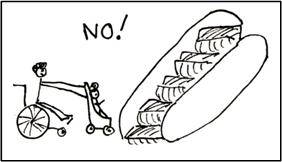 If traveling with a mobility device (wheelchair, stroller), please use elevators.
If traveling with a mobility device (wheelchair, stroller), please use elevators.
— source: TTC Escalator Safety Steps Pamphlet |
Take the escalator when possible — a moving escalator is statistically safer than stairs — but if an escalator has stopped, take the stairs, as escalators are designed to be used while moving, and they are actually less safe than stairs when immobile.
— submitted by anonymous
Shopping Tips
If you are shopping at a store in Fairview Mall and they do not have your size, ask the salesperson to ring up the store in Scarborough Town Centre. If they have it, STC is merely a 190 Rocket Express bus ride away — 10 to 15 minutes, runs every 15 minutes
— submitted by girlswear
Warden Station's Café on the Go has the best pizza. Their crust is incredible! They also have oriental baked goods, spring rolls, fried rice, samosas and patties.
— submitted by girlswear
Warden Station's shops are so ghetto, but everything you need is there.
— submitted by girlswear
The accessories store beside the Tim Hortons at Finch Station is not bad.
— submitted by girlswear
The Bathurst Station bakery has the best baked goods.
— submitted by anonymous
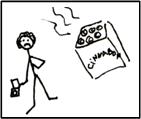 Eglinton Station's Cinnabon makes tasty cinnamon buns that smell good, but they are heavy in the stomach.
Eglinton Station's Cinnabon makes tasty cinnamon buns that smell good, but they are heavy in the stomach.
— submitted by anonymous |
For stores and restaurants that have entrances from both the fare-paid area, and from the outside (e.g., McDonald's at Dundas West Station), pick the entrance with the shorter line for faster service.
— submitted by Jack Phelan
The exit from Queen Station on the north end of the northbound platform is quite possibly the best way to get to the Eaton Centre, as you emerge right in the middle of the mall.
— submitted by Theresa Aqui
If you're waiting at Finch Station, and you're hungry, you can get snacks 24 hours a day at the Esso just south of the station.
— submitted by payroll
Your Metropass will get you discounts at various places as part of the Metropass Affinity Program. Your Metropass will also get you discounts at other places through direct partnerships between organizations and the TTC, although it's difficult to know when and where these discounts are offered.
— submitted by anonymous
Tips for the Self-interested
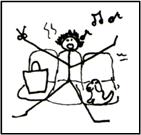 Ways to get people not to sit beside you:
Ways to get people not to sit beside you:
— submitted by Kris, Michael Higginson and grapestain Teenagers are significantly more likely to ride at the back of the streetcar. Keep this in mind, depending on whether you like or dislike sitting with teenagers. — submitted by Michael Higginson On crowded vehicles, stand so other people's bodies will cushion a crash. — source: Post Secret When transferring lines at crossover stations, walk like you're seven feet tall. If you keep your head up, people traveling in the opposite direction are far less likely to walk directly in front if you. — submitted by Dried Fruit If you see an old person getting on and you don't want to give up your seat, close your eyes and pretend you're sleeping. — submitted by Mislav If you're on crutches and sitting in the front seat — don't get up for elderly women — even if they swear at you. — submitted by Kerry anne Tips About PatienceIf you board a bus or streetcar shortly before a major transfer point (e.g., Yonge Street), don't worry about getting a seat right away — rather, move to the middle of the bus, and after the vehicle empties out at the transfer point, take your pick as to what seat you'd like. — submitted by Todd Irvine Looking down the street to see if the bus or streetcar is coming is a good option if you are feeling impatient. — submitted by Michael Higginson The bus comes when it comes. — submitted by Sunny For events (e.g., parades), the TTC is usually the better way, but still set your expectations for longer than usual waiting times, especially if catching the TTC immediately after the event lets out. For those who complain about not having enough time to read, consider this extra time a bonus feature of the TTC. — submitted by anonymous If the bus is taking too long, light a cigarette, and it will appear immediately. — submitted by anonymous Getting a SeatIf you get on a crowded 504 or 505 streetcar heading south from Broadview station, stand next to any elderly seated Chinese passenger. Chances are they'll get off at Gerrard — and you'll get a seat. — submitted by building babel Plan your route to get on the subway before it hits the busy stations. For example, if you're at Queen and Parliament, and you want to travel west on the Bloor subway, you could take the streetcar to Queen Station and go north to Bloor, or you could take the bus north to Castle Frank Station and then go west. By choosing the latter option, you would get on the subway before it hits the busy Yonge-Bloor intersection, and thus secure yourself a seat. — submitted by Jack Phelan On a busy streetcar, squeeze through to the back — even if it's packed with people, there are often seats still available at the very back. — submitted by Julie Fournier During peak times, if crossing over from the Spadina-University line to the Bloor-Danforth line, cross at Spadina if going eastbound (before people get on at St. George) or cross at St. George if going westbound (before people get on at Spadina). Note that if you cross subway lines at Spadina, you will have to do the long walk between the two. — submitted by m roboto If you're going east from St. George, and you can't get a seat, not to worry — most people are going to empty out at Yonge and you'll definitely be able to grab one after that. — submitted by scarberiankhatru If you have Proof of Payment (a transfer or pass), you can board the Queen streetcar through the back doors at busy intersections. — submitted by anonymous When getting on a bus or streetcar at a crowded stop (e.g., outside a college or at a major intersection), walk back one stop and get a seat before the bulk of the passengers board at the next stop. For example, if taking the 501 Queen streetcar west, walk one stop east to Victoria Street and board there. — submitted by spmarshall
If you have to travel the Yonge subway line during rush hour, consider taking the 97 Yonge bus instead. It takes only slightly longer, but there's a better chance of getting a seat or at least a place to grab hold. — submitted by Chris To know where the rear door will be when the bus arrives at the station, observe the wear pattern on the yellow curb. Positioned to board quickly, you might get a seat. — submitted by Bill Andersen For frequently used routes, figure out what door to stand at when the bus or streetcar pulls into the station. For a bus, you can stand at the front door, to the left of the back door, or to the right of the back door. When the bus empties, one of these doors will free up first. In many cases, sometimes to the right of the back door is the best place to stand, as the back of the bus empties out to the left of the back door, and the majority of the front of the bus empties out the front door, leaving the minority of passengers to empty out the right of the back door. — submitted by anonymous During rush hour in the morning, the TTC introduces new trains southbound beginning at St. Clair West station. The result is nearly every other train from St. Clair West is empty. If you're waiting at St. Clair West, Dupont or Spadina during a weekday morning, and you see a train that's packed with people, it's worth the extra few minutes wait for the next train. — submitted by Matthew Klug Catching the Next TrainTrain your ears to recognize if your train is the one that barrels into the station loudly and then starts to become quiet, or if it starts quiet and then becomes louder. This works well when the stairs are close to one end of the platform and one train is loud as it enters the station near the end you come in, while the other train is quiet as it enters the station from the other end of the platform. — submitted by groshbarr In stations with two platforms divided by the tracks, you can tell if an approaching train is yours by the noise it makes. If the screeching, clicking and clunking sounds are loud and clear, it's not your train. But if the sounds are quieter and muffled, it is your train. This is because the platform blocks the noise coming from the train's wheels and brakes as it rides directly beside it. — submitted by pjs If people are coming up the stairs or escalator on the side that you are going down, there is likely no need to rush, as you probably just missed your train. — submitted by Jonathon Markowski If people are coming up the stairs or escalator from the platform opposite to the one you are going down, and then you hear a train coming into the station, you should rush to catch it. — submitted by anonymous While paying your fare, look at the video screens in the collector's booth. Use them to judge whether your train is coming (and you should rush), your train is in the station (and you can take it easy, as it will be gone by the time you get to the platform) or the train going the opposite direction is coming or already in the station (and you know now to rush if you hear a another train coming as you approach the stairs going down). Screens are often labeled with E/B, W/B, N/B and S/B (eastbound, etc.). For frequently used stations, memorize which screen is for which direction. — submitted by Yermum If you hear a train pulling into the station while you are walking down the stairs to the platform, look to see if the people further down the stairs who can see which train it is are hurrying. If they are, you should too. — submitted by Wes Hodgson For centre platforms, while on the stairs, look at the floor at the bottom — you can sometimes see glints of the indoor lighting from the train beside the platform, and you'll be able to determine which direction the train in the station is going. — submitted by anonymous
Know the subway stations where the trains sometimes pause (and that it's worth rushing for a train even if you are at the top of the stairs). Pause stations: Bloor, Chester, Christie (westbound), Coxwell, Eglinton, Ossington (eastbound), Royal York, Union. — submitted by bangersandmash It takes 4.7 seconds from the time the closing door chime first begins until the train door is completely closed. Pace yourself accordingly when you hear the chime. — submitted by Matthew Blackett From the outside of Lawrence station, or up above the platforms in the station, you can sometimes see northbound or southbound trains approaching — use these to gauge whether you should rush down to the platform. — submitted by David Teitel Catching the Next Bus and StreetcarIf you just missed the bus, look down the street to see what the streetlight is doing at the next intersection. If the stop walking sign is blinking, run fast and you might be able to catch it. — submitted by Darryl Matton When exiting up the subway steps to catch a streetcar, listen carefully for the streetcar's distinctive hum; if it suddenly rises in pitch, this mean it's revving up and leaving. If it's low and continuous, this means it's idling and you have a chance to catch it. — submitted by gyip Sleeping Tips
If you want to catch some shut-eye on the train, you can tell when certain stations are coming up by the rumble that the train makes as it passes by a switch, or by the grinding and squealing noise it makes as it rides along a curve. e.g., if you're traveling westbound on the Bloor-Danforth line, you know Broadview is next by listening for two rumbles followed by a squeal. — submitted by anonymous Entertaining Yourself En RouteIf you are at the front of the first car heading eastbound toward Bay, you can see the entrance to Lower Bay Station. They leave the lights on. — submitted by drooling If you want to see Lower Bay, somehow become involved with a film or commercial shoot down there (e.g., as an extra). — submitted by Julie Fournier Taking the Spadina streetcar between Spadina and Union Stations takes you on a tour through some of the most interesting parts of Toronto — Chinatown, what should be referred to as SkyDome, and Harbourfront — without you having to pay another fare to continue on your way. — submitted by Darwin O'Connor Standing by the door while going over the viaduct between Castle Frank and Broadview Stations gives you a splendid view of the Don Valley. — submitted by anonymous Go on a tour of the Sheppard Subway line — each Station was designed by a different artist (editor's favourite: the individually signed Leslie & Sheppard tiles at Leslie Station). — submitted by anonymous Use a ride guide to make all sorts of cool transit stuff — cut them out to make buttons, covers for diaries, etc. — submitted by anonymous
Memorize all the subway stops in order. Sit in a place where you can see the map and close your eyes. List each stop as you pass them. Open your eyes every now and then to see if you're correct. — submitted by anonymous Play subway trivia games as you travel with friends. e.g., what stations have the word Queen in them; what stations begin with Saint; what station is between Ossington and Bathurst; what's the only station that begins with the letter F; what letters do no stations begin with? Make up questions while traveling. — submitted by anonymous Visit transit websites and then when you travel, admire the history, quirkiness and beauty of each station: Transit Toronto Spacing's Photo Essay: The Details of the TTC Infiltration's The Better Way ttcrider.ca's Quirky Stations — submitted by anonymous The TTC occasionally adds and removes various routes, but they don't always remove their schedules. On the internet, go to www.toronto.ca/ttc/schedules/128N.htm, and you will find the schedule for Route 128 Brimley North, a route long gone. Try also /197N.htm and /171W.htm for routes 197 Yonge North and 171 Progress East. These routes no longer exist. — submitted by Jonathon Markowski If you're heading westbound from Warden Station, sit close to the back of the last subway car on a forward-facing seat on the right-hand side of the train. Between Warden and Victoria Park, the train will bend around the track. Look out the window and you will see the front of the train off in the distance. It's a neat feeling being able to see the front of the train as you're sitting at the very back. It gives you a sense of how long the trains really are. — submitted by Leo Gonzalez Observe how the bus terminal at Downsview Station looks like a mini-Pearson Airport. — submitted by Calvin So Pick up a free cardboard model of a TTC streetcar or bus at TTC Headquarters, 1900 Yonge Street (Davisville Station). — submitted by anonymous More than Just a RideTo check what time it is, press the French/English language button twice on a Bell payphone. It will almost immediately display the time. — submitted by Mason Wright and samsonyuen
You can catch a private shuttle bus from Leslie's Sheppard Avenue street exit to the upper exit of Ikea North York. — submitted by Jim Tait You can take a free shuttle bus between Union Station and Ontario Place. This bus will get you to the CNE too. — submitted by rstewart You can distinguish the modern subway cars with the wider doors from the older ones by looking at the front lights of the train as it enters the station. The old car front lights are lower than on the new cars. — submitted by gleikis2004 It's sometimes possible to get cell phone reception between Eglinton Station and Bloor Station. — submitted by Rajiv O Pick up a free ride guide from the collector booths at subway stations. — submitted by anonymous You can bring your bicycle onto the subway, RT and streetcars during non-peak hours (9:30 a.m. to 3:30 p.m. and 6:30 p.m. to 6:30 a.m. during the week, and anytime on the weekend). Certain bus routes have bike racks on the buses. See the TTC's Rack It and Rocket! website for details. — submitted by anonymous For less than $150 you can purchase a radio scanner that can monitor TTC frequencies, allowing you to stay on top of developments on the system as they happen. The knowledge you gain will allow you to re-route around problems and understand why a delay might be taking place. For more information, see Transit Toronto's TTC radio - some background information article — submitted by Rob Stewart If you're looking for something to read on the subway, and you're lining yourself up at the correct door in order to be closest to your exit escalator, board the car at the door farthest from the door you intend on eventually exiting. You can then casually stroll through the entire car from one end to the other, along the way picking up the discarded newspapers from the seats that you wish to read for your commute. — submitted by anonymous Useful KnowledgeThe 308 Finch East Blue Night bus arrives at Finch and Yonge every half hour on the half hour. — submitted by payroll To estimate the time of your subway journey, count two minutes per stop. For example, if you're traveling 8 stops, it should take roughly 16 minutes. This of course varies with stops. Stops towards the end of the lines take longer than 2 minutes between each station. — submitted by payroll Being familiar with the TTC route numbering scheme can aid moving around the city: 1 - 139 Regular bus routes 140 - 159 Downtown Premium Express routes 160 - 189 Regular bus routes 190 - 199 "Rocket" Express routes 200 - 299 Routes that primarily serve areas outside the City of Toronto 300 - 399 Routes in the overnight "Blue Night Network" 400 - 499 Accessible "Community" routes operated by Wheeltrans 500 - 599 Streetcar routes — source: Transit Toronto When you've been waiting for the bus for a while near the end of its route, the bus will likely come from the opposite direction you're traveling, as it will have to loop around first before heading back to the subway station. For this reason you can take it easy while you're waiting, and when you see the bus pass by you going in the opposite direction you're traveling, know the bus is just minutes away from turning around and coming up in your direction. You may even have time to go to a convenience store, if you keep your eyes on the road to see when the bus passes by you going the other way — giving you a few minutes warning. — submitted by anonymous At the end of a bus line, the bus usually doesn't return on the same street it arrived on, as it can't do a u-turn, but rather uses smaller side streets to turn around. Therefore, wait for the bus in the opposite direction you want to travel. For example, there is no stop going north at the Queen and Lansdowne intersection. Catch the bus at the stop going south, and the bus will turn around using side streets, and then come out onto Lansdowne a block north of Queen Street. — submitted by anonymous Tune into Metro Morning and Here and Now on CBC Radio 99.1 and Breakfast Television on CityTV for TTC updates before you take your trip. — submitted by anonymous Visit Transit Toronto Service Alerts. — submitted by anonymous Visit transit.toronto.on.ca for general news about transit in Toronto. — submitted by anonymous Courtesy, PleaseWhen you are sitting on the subway, and someone needs to get by you, stand up and let them by — do not just turn your knees. — submitted by m roboto Take an inside seat instead of blocking it by sitting on the outside seat. — submitted by m roboto On the escalator, stand on the right side, and walk on the left side. — submitted by tyrone When giving up your seat to a pregnant or elderly person, directly offer that person the seat as you are getting up. This avoids another person taking the seat you are generously offering. — submitted by Liza Badaloo Do not put your bag or backpack on the seat next to you — put it on your lap or on the floor in front of you. — submitted by cppainter2001 Move to the back of the bus and streetcar after boarding. — submitted by cppainter2001
Keep your knees together when you are sitting beside a stranger. — submitted by cppainter2001 While buying tickets, move ass to allow others with tickets to slide by. — submitted by Lisa Smolkin Take off your backpack before boarding a TTC vehicle. — submitted by m roboto Do not obstruct exit doors on TTC vehicles — particularly in the inside doorway of a subway train. — submitted by cppainter2001 Let everyone off the TTC vehicle before trying to board yourself. Expect an elbow if you don't. — submitted by Matthew Blackett
Use the waiting time at bus and streetcar stops to dig out your fare. That way, when everyone is boarding, you won't have to find it and hold everyone up. — submitted by Anya Galkina Place used newspapers in the proper recycling bin. If you want to promote re-use, and the paper is clean, consider putting it back into its original box (if it's a free newspaper) or into an empty news box (for the free papers) if it's a paid for paper — whoever opens it will be pleasantly surprised with a free paid for paper. Don't leave it on the train as it may end up on the floor. — submitted by anonymous If you have a nice newspaper that costs money and is in good condition, leave it on the TTC for somebody else to read. — submitted by anonymous The rear doors on the new low-floor buses take a long time to close. If it will save time for everyone else, consider exiting from the front door. — submitted by anonymous Do not smoke on TTC property or at the entrance of TTC subway stations. Others deserve not to have to breathe your second-hand smoke. — submitted by anonymous Don't throw newspapers on the ground. — submitted by anonymous Don't place your cup, water bottle, etc. on the ground of the subway train. It will fall over within minutes of you leaving and roll around the train for the remainder of the day. Dispose of it and all other garbage properly. — submitted by anonymous Don't wear perfume, cologne, or other chemical fragrances on the TTC, as many people are allergic to them and you might make them ill. — submitted by Cynthia Gould Be nice to other TTC passengers and staff. — submitted by m roboto Tips to Aid You Using the TTC Subway Rider Efficiency GuideIf you're on the platform, the train is paused, and you want to get into the right car to line yourself up properly at your destination's exit, you can watch the traffic signal at the end of the platform. The train won't move while it's red. The train will remain until the signal turns yellow or green. When you see it change, hop into the train using the closest door. — submitted by Jack Phelan If you're switching subways at St. George, line yourself up with the exit at your final destination Station, as the University line St. George Station is directly on top of the Bloor line St. George Station. Each train faces the same direction, so the doors are in the same place. — submitted by Jack Phelan
Use the DWA sign to line yourself up to the 5th car, 1st door. Use the DWA sign on the opposite platform to line yourself up to the 2nd car, 4th door. — submitted by Mike Olivier and Geoffrey Wiseman Use the coloured dots to line yourself up at the right door: Front of train: Red dot (your platform) 2nd car, 4th door: Green dot (opposite platform) 3rd car, 3rd door: Orange dot (your platform) 4th car, 2nd door: Orange dot (opposite platform) 5th car, 1st door: Green dot (your platform) Back of train: Red dot (opposite platform) — submitted by anonymous If while waiting on the platform, the train going in the opposite direction pulls into the station, you can use it to line yourself up — the doors of the opposite train will be reversed with the doors of the train going in your direction. e.g., if you want to line yourself up at the 2nd car, 3rd door, you would line yourself up at the 5th car, 2nd door of the opposite train. 1-1 lines up to 6-4 (1st car, 1st door of opposite train lines up to the 6th car, 4th door of your train) 1-2 lines up to 6-3 1-3 lines up to 6-2 1-4 lines up to 6-1 2-1 lines up to 5-4 2-2 lines up to 5-3 2-3 lines up to 5-2 2-4 lines up to 5-1 3-1 lines up to 4-4 3-2 lines up to 4-3 3-3 lines up to 4-2 3-4 lines up to 4-1 4-1 lines up to 3-4 4-2 lines up to 3-3 4-3 lines up to 3-2 4-4 lines up to 3-1 5-1 lines up to 2-4 5-2 lines up to 2-3 5-3 lines up to 2-2 5-4 lines up to 2-1 6-1 lines up to 1-4 6-2 lines up to 1-3 6-3 lines up to 1-2 6-4 lines up to 1-1 — submitted by anonymous Use the guide to win urban games, e.g., Race in the City. — submitted by anonymous When providing directions to your home, tell people what car and door they should line themselves up to at the station closest to your home. e.g., if someone is coming from the west, and you live near Pape Station, tell them to make sure they're on the 4th car and at the 3rd door when they board the train on the Bloor line. — submitted by anonymous Board the train at the exact door you want to exit and sit in a seat close to that door. Sometimes it's possible to forget that you intended to be at a certain door by the time you get to your destination, so it's best just to be close to the door you intend on exiting so there's no need to remember. As well, sometimes the car is too full to move around, and you won't be able to get to the best door to exit. — submitted by anonymous If you don't have time to line yourself up to the right car at your originating station because the train is there as soon as you arrive, transfer one car at a time between stations. — submitted by anonymous When printing maps for invitations, also include a subway platform map of the station closest to the party. — submitted by anonymous While waiting for the subway train, spend the time by walking on the platform to the best position for when you get off. Either way, you will have to walk that distance, so it's better to walk while waiting for the train instead of after you get off the train at your destination. — submitted by Mark Kalzer Download, print, cut and staple a free TTC Subway Rider Efficiency Guide. It has platform maps of all the subway and RT stations so that you can line yourself up with the exit at your destination station. — submitted by anonymous Tips for When Your Kids Start Traveling On Their OwnPoint out familiar landmarks to your child — like banks or churches on corners, etc. Do this for transfer points en route and for their final destination. — source: Jacquelyn Francis / Globe and Mail Ensure your child has tickets before they leave the house for the day. — source: Jacquelyn Francis / Globe and Mail Make sure your child has emergency money — enough for a taxi and quarters for a payphone. — source: Jacquelyn Francis / Globe and Mail Before your child does their main route (e.g., from home to school), have them ride the TTC a few times between your home and a close friend's house. — source: Jacquelyn Francis / Globe and Mail
If at all possible, travel part of the way with your child. — source: Jacquelyn Francis / Globe and Mail Speak with neighbours or your child.s school to find your child a buddy to travel with. — source: Jacquelyn Francis / Globe and Mail Educate your child about transit safety features, including the designated waiting area, the emergency call phone, and the alarm bar within the subway. — source: Jacquelyn Francis / Globe and Mail Point out what a Transit Special Constable looks like and what their role is (they have the power of a police officer on TTC property). — source: Jacquelyn Francis / Globe and Mail Establish a spot in your child's bag or on their clothing where they can store extra money and carry spare transit tickets. — source: Jacquelyn Francis / Globe and Mail Determine a system or routine; know your child's patterns and when they should be home. Have them call you when they arrive home. — source: Jacquelyn Francis / Globe and Mail If it makes you comfortable, consider buying your kids cell phones. — source: Jacquelyn Francis / Globe and Mail Tips for Traveling with Young Children
Stand behind your small child and over to the side as they walk up stairs and escalators. Stand tall and proud and make it clear to others that this space is for your child and that they will have to go around you. — submitted by anonymous Let your children get the transfers, pull the stop request wire, and press the stop request button. They like doing these sort of things. — submitted by anonymous For longer journeys, bring a book, a toy, something to drink and a snack. — submitted by anonymous When riding with small children, travel at the very front or very back of the train — whatever car is the furthest from the exit. This way when the train exits, you can take your time knowing your child won't be stampeded by people rushing behind you. — submitted by anonymous Use your young child to your advantage — often you'll get offered a seat because you have a child, or you may be able to butt into line because you have a child. — submitted by anonymous
“TTC Subway Rider Efficiency Guide Archive” is a derivative of “TTC Subway Rider Efficiency Guide” by Sean Lerner, used under CC BY-NC-SA.
“TTC Subway Rider Efficiency Guide Archive” © 2022 by bunnyhero is licensed under
CC BY-NC-SA 4.0 |
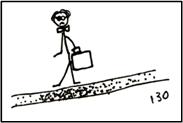 When taking the subway, check the edge-of-platform yellow strip. The train doors usually open where the strip is at its grubbiest. (This doesn't necessarily work if the platform hasn't been renovated recently and it's grubby everywhere.)
When taking the subway, check the edge-of-platform yellow strip. The train doors usually open where the strip is at its grubbiest. (This doesn't necessarily work if the platform hasn't been renovated recently and it's grubby everywhere.)
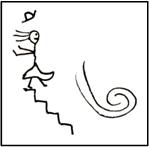 When going down the stairs to the platform, you can sometimes tell the direction the train is traveling by the wind it generates. If you feel a strong gust, it means the train is coming from the opposite direction of the stairs you are going down.
When going down the stairs to the platform, you can sometimes tell the direction the train is traveling by the wind it generates. If you feel a strong gust, it means the train is coming from the opposite direction of the stairs you are going down.
 Carry something soft (hat, scarf, etc.) in your bag, and when you feel tired, you can put this between your head and the hard window and have a snooze. This is much more comfortable than leaning directly on a window.
Carry something soft (hat, scarf, etc.) in your bag, and when you feel tired, you can put this between your head and the hard window and have a snooze. This is much more comfortable than leaning directly on a window.
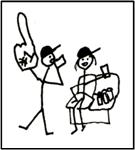 You are allowed to drink beer on the subway, if the Blue Jays have won the world series that night.
You are allowed to drink beer on the subway, if the Blue Jays have won the world series that night.
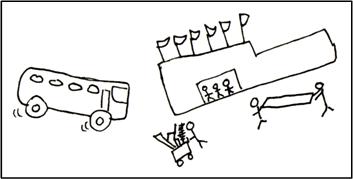 You can catch a private shuttle bus from Kipling Station's south parking lot to the front door of Ikea Etobicoke.
You can catch a private shuttle bus from Kipling Station's south parking lot to the front door of Ikea Etobicoke. When you are on the stairs, and you can see the train pulling into the station is yours, exaggerate your body language to cue those behind you so they know to hurry up. Swing your arms, etc.
When you are on the stairs, and you can see the train pulling into the station is yours, exaggerate your body language to cue those behind you so they know to hurry up. Swing your arms, etc.
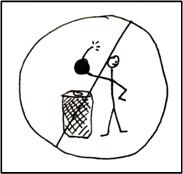 Do not put bombs in the trash cans.
Do not put bombs in the trash cans.
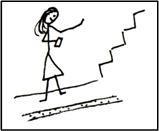 Use the guide to get off at the least popular exit to avoid crowds.
Use the guide to get off at the least popular exit to avoid crowds.
 Do several practice trips with your children, familiarizing yourself and them with the route.
Do several practice trips with your children, familiarizing yourself and them with the route.
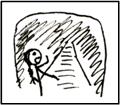 When riding with young children, sit at the very back or very front of the train. Turn what might otherwise be a boring commute into a fascinating journey. They love to kneel* on the seats, look out the window and watch the train roar through the tunnels.
When riding with young children, sit at the very back or very front of the train. Turn what might otherwise be a boring commute into a fascinating journey. They love to kneel* on the seats, look out the window and watch the train roar through the tunnels.